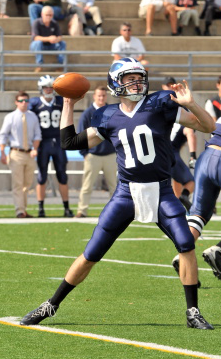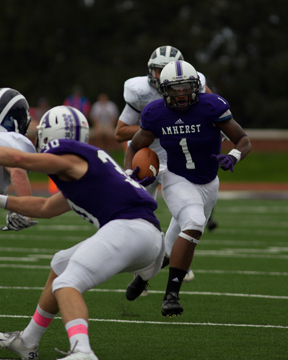This post was written by Adam Lamont, a sophomore at Bowdoin. Lamont is a former member of the Bowdoin football team.
Offensive MVP: McCallum Foote (Middlebury)

Though not as prolific as he was in 2012, McCallum Foote still means more to his team than any other player.
Foote has not managed to repeat last year’s gaudy numbers in terms of efficiency, but he is averaging over 340 yards per game, which is 120 yards more than Jake Doll, the second highest passer in the league. Middlebury’s win over Bates, Saturday, was Foote’s best performance of the year, earning him NESAC Player of the Week honors. The senior threw for 305 yards and two touchdowns while completing 35 of 61 passes, but his biggest plays came with his legs—an underrated aspect of his game. Even when he played terribly in the Amherst game, throwing five interceptions, his value was underscored as his 450-plus yards of passing kept the game close until late. No other player in the NESCAC requires the game planning that Foote does because of his arm. Even without a very consistent running game, the Middlebury offense moves up and down the field because Foote can make every throw consistently. To be sure his 9 interceptions so far this year show he is not perfect, but he is working with a revamped receiver core and young offensive line. He will go do down as one of the all time great quarterbacks in NESCAC history.
Defensive MVP: Landrus Lewis (Amherst)
The senior cornerback for Amherst has been the leader of a defense that has been the key to Amherst’s 4-1 record, ranking second in the NESCAC in points allowed and total defense and first in takeaways with an astounding 15 interceptions. Lewis has accounted for three of those picks, including two in Amherst’s big win over Middlebury and has amassed 129 return yards, tops in the NESCAC. He does not make too many tackles from his corner position, but at 5’11 193 he is stout and has even recorded a sack this year. His ability to cover so much space on the back end frees up the Amherst safeties to take chances in the box. The defense for the Lord Jeffs has been great all around and you make an argument that a number of players from that unit deserve this award.
Coach of the Year- Mike Whalen (Wesleyan)
This has been an unbelievable season for Wesleyan so far and Mike has been the engineer behind it all. Whalen is a Wesleyan graduate, but his first head coaching job in the NESCAC came at Williams where he lead the team to a collective 38-10 record over his six seasons. After the 2009 season, Whalen decided to return to his alma mater to lead a program that has not enjoyed a whole lot of success over the years. The decision might have been risky, but Whalen has done an incredible job. To figure out Wesleyan’s success, look no further than the junior class that was Whalen’s first recruiting class and is highlighted by QB Jesse Warren and Running Backs Kyle Gibson and LaDarius Drew. The somewhat unorthodox offense that Whalen runs has been nearly unstoppable, averaging a conference-best 36.6 points per game. After toughing out a win on the road over Amherst, Wesleyan has cemented its status at the top of the conference. Whalen should easily win Coach of the Year for the turnaround at Wesleyan.
Freshman of the Year- Chase Rosenberg (Hamilton)
I don’t think that Rosenberg has been the best freshman so far, but as a freshman quarterback he has made the biggest impact. Selecting him here is partly to note that though he has not played at an all-conference level so far, Rosenberg could be a very good quarterback going forward. With running back James Stanell missing time this season, Rosenberg has had a lot of responsibility and dealt with it impressively. He played very well two weeks ago against a decent Bowdoin defense, passing for 269 yards passing and a healthy 8.4 yards per attempt. He continued to play well last week throwing for 273 yards, 2 TD’s (and 2 INT’s) against Colyb. After only throwing the ball 12 times in each of the first two games, Rosenberg is starting to develop into a quarterback that could help turnaround the program under Coach Andrew Cohen. Others will argue that other freshman have been more consistent, but Rosenberg’s improvement as a quarterback with limited help earns my vote.
Midseason All-NESCAC Team
Offense
Quarterback: Jesse Warren (Wesleyan)
It feels strange not selecting McCallum Foote here, because in yardage he absolutely blows everybody away, but Warren gets the nod because he has managed to play error-free for a Wesleyan team that has evolved this season into an offensive juggernaut. He doesn’t have to carry his offense, but a 12:0 touchdown-to-interception ratio is hard to quibble with, particularly while completing over 70% of his passes. Warren bolstered his case last week against a ball-hawking Amherst secondary, making enough throws to win, none bigger than the huge fourth quarter touchdown pass—a 42-yarder to Kevin Hughes that was ultimately the difference in the game. Intuitively it might not make a lot of sense to make Foote League MVP while Warren gets first team honors, but my reasoning is that Warren has been the best quarterback because he hasn’t made mistakes. Foote is MVP because without him the Middlebury offense scores ten points a game. My reasoning requires a certain understanding of the criteria for first team versus Most Valuable Player, but the loose definition of MVP means I can argue both sides.
Running Backs: LaDarius Drew and Kyle Gibson (Wesleyan)
More Wesleyan players? The real question is what they put in the water down in Middletown, because this Wesleyan team appeared unstoppable before last week’s game against Amherst. Drew and Gibson form a great one-two with Drew receiving more carries, but Gibson providing a home-run threat, averaging an unreal 8.2 yards per carry through half the season. Drew has been dynamic as well, with 5.0 yards per carry and a league-leading 7 rushing touchdowns. They benefit from great offensive line play, but both of them are great runners in their own right, who complement one another perfectly.
Wide Receiver 1: Matthew Minno (Middlebury)
Minno rebounded from a down game against Williams two weeks ago with a solid 7-reception game against Bates. Minno leads the NESCAC with 390 receiving yards and is fifth in the conference with 29 receptions—the fourth of five Middlebury players in the top five in receptions. He has emerged as the outside threat to replace Zach Driscoll, but has not been as consistent in the red zone, recording just two touchdowns so far. The bottom line is that while Minno has the fourth most receptions on his team, he separates himself from the pack because of his yards per catch rate—a shade above 13-yards per reception.
Wide Receiver 2: Jake O’Malley (Amherst)
He is the number one receiver for a one-loss Amherst team whose offense has been decent but far from overpowering. O’Malley is a long, athletic receiver, but also an above average who has long been a contributor for Amherst, but has elevated his performance in his last year. He played very well in the second half against Wesleyan when Amherst had to throw the ball more downfield to come back. His speed and size combination has allowed him to average almost 14 yards per reception.
Tight end: William Sadik-Khan (Middlebury)
In addition to winning NESCAC Name of the Year, Sadik-Khan has filled in admirably for departed All-American Billy Chapman. Having Sadik-Khan control the middle of the field makes him the most important pass catcher on the Panthers. While he doesn’t have Minno’s explosiveness, he leads the league with 38 receptions.
Offensive Line: Wesleyan
I would be lying if I said I had any idea who the best individual linemen in the NESCAC are through five games. Rob Wasielewski is a very talented tackle for Amherst, but beyond him it is hard to separate specific players. As offensive line is arguably the most important positional unit in the NESCAC, I feel bad not having the knowledge to single out specific players. As a unit, however, Wesleyan’s has been the best, demonstrated by the team’s great balance between the run and pass. Some lines are great pass protectors, while others excel at opening holes in the rushing game, but the Cardinals’ unit has distinguished itself this year by doing both.
Defense
Defensive Lineman- Jake Prince (Bowdoin), Max Lehrman (Amherst), James Howe (Williams)
Prince has been a revelation his junior year with 3 sacks and 7.5 tackles for loss. He benefits from playing aside 2012 All-League player CJ Johnson, but Prince has been the more disruptive force blowing up blockers all year. Lehrman has 4.5 sacks and is the leader of a defensive line for Amherst that is the best in the league, allowing a conference-low 89 rushing yards per game, while registering 12 sacks, second only to Colby. Howe, meanwhile, has been one of a few bright spots for Williams with 5.5 sacks on the defensive line, four of which came last weekend against Tufts.

A year after being sidelined by injury, Lewis has been the conference’s most dominant defensive player. (Amherst Athletics)
Linebackers: Griffin Cardew (Bowdoin), Chris Tamasi (Amherst), Joey Cleary (Bowdoin), Michael Weatherby (Trinity)
Cardew and Cleary, who will be forever remembered for their appearance in the SportsCenter Top 10 for their 99- and 100-yard interception returns for touchdowns in 2011, have had stellar 2013 seasons. The two tackling machines have led a Bowdoin defense that is great against the run, but suspect against the pass. Cleary leads the league in tackles with two interceptions and four pass breakups to boot, while Cardew was third in tackles through four game before leaving the game against Trinity last week with an injury. Cleary has also registered a sack and forced fumble. Ned Deane is the leading tackler for Amherst and has been a playmaker in the middle, ercording an interception and 1.5 sacks, one of only three linebackers to do so this season. Weatherby, meanwhile, is the latest in a long line of strong Trinity linebackers. Though he’s only made 31 tackles so far this season, Weatherby has made them count, racking up the league’s third-most tackles for a loss (7.5) through five games.
Defensive Backs: Landrus Lewis (Amherst), Nate Leedy (Middlebury), Zach Padula (Colby), Max Dietz (Amherst)
The case for Landrus Lewis has already been made (and in this case the MVP accurately reflects his place as a first-team performer as well). On the other side, Nate Leedy has stepped in as a freshman and has far exceeded expectations for the Panthers. From the corner position he has recorded 24 tackles and 6 pass breakups—the most in the NESCAC. Padula is a very solid safety in coverage for Colby with 3 interceptions, 4 pass break ups and 1.5 tackles for loss through five games. Dietz is another cog in an Amherst secondary that has been tremendous at taking away the football. Dietz is one of three Amherst defensive backs with 3 interceptions, but has separated himself from the pack with 25 tackles—22 solo—and 5 pass breakups, the most on the team.

Excellent topic, however, I must add that Wesleyan is not winning simply because of it’s offense. The DEFENSE is turning teams over and providing the OFFENSE with additional opportunities to put points on the board. Guys like Donnie Cimino, Jake Bussani, Justin Sanchez, Vincent Davis, along with freshman Devon Carrillo create the most dynamic secondary in Division III football…PERIOD Throw in 6’7″ DE Nik Powers, gifted hole stuffer, Dee Simon is and Linebacker-Convert, Myles Beard, this is the STINGIEST defense in the league and that is by no accident!